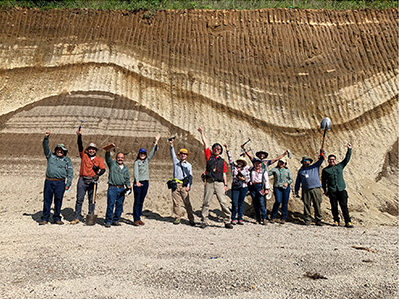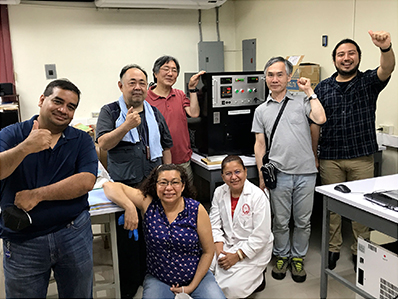MASTER TECHNIQUES from Japan to the World 1
Japan’s Leading-Edge Research Promotes Geothermal Power Development in El Salvador

A field survey to collect rock samples for exploration using thermoluminescence near the Ahuachapán Geothermal Power Plant (Photo: JICA)

Thermoluminescence measurement equipment provided to the University of El Salvador. This equipment, originally developed by Tohoku University, enables exploration for prospective geothermal sites. In addition, an X‐ray Fluorescence (XRF) analyzer and an Inductively Coupled Plasma Optical Emission Spectroscopy (ICP-OES) have also been provided. (Third from the left (back row): Dr. Tsuchiya) (Photo: JICA)
In El Salvador in Central America, where volcanoes are distributed across the country, geothermal power generation is an important energy source that accounts for approximately 27% of the domestic power supply and demand. Currently, El Salvador promotes the further development and use of geothermal power generation, a renewable energy source, in order to reduce thermal power generation, which accounts for approximately 25% of total power generated. However, due to the difficulty in proceeding with geothermal power development on its own, the Government of El Salvador requested Japan to provide technical cooperation through JICA. Based on the request, Japan has implemented the “Project for Thermoluminescence Techniques in Geothermal Exploration and Integrated Evaluation System of Geothermal Reservoir” in El Salvador since 2018 under the Science and Technology Research Partnership for Sustainable Development (SATREPS) program. Note 1
Thermoluminescence Techniques Note 2 are Japan’s unique techniques that Dr. TSUCHIYA Noriyoshi, Professor of the Graduate School of Environmental Studies, Tohoku University, and principal investigator of this project, has advanced the research and development on for over 20 years. These techniques can be applied to narrow down promising areas for geothermal development inexpensively and efficiently. The project is working on the technical transfer by inviting faculty members from the University of El Salvador and engineers from geothermal power company to Japan to learn relevant leading-edge technologies that are under research in Japan, or by holding workshops in El Salvador with lecturers from Japan. “It is crucial to have people understand the importance of principles as well as the know-how of the technology. The speed of development in El Salvador is much faster than in Japan, so it is interesting to see how our research and new technologies are being rapidly put to practical use,” said Dr. Tsuchiya. Through this project, geothermal power development has already commenced at four sites, while geothermal exploration is ongoing at another four sites.
The project has also achieved significant results in terms of human resources development and research and development. Researchers at the University of El Salvador developed a world-first geothermal technology after deepening their knowledge and conducting multiple experiments in Japan, and their paper was published in a prestigious international journal. It is expected that learning from Japan will foster researchers in El Salvador and promote geothermal research in their country.
Dr. Tsuchiya also hopes that young researchers, who will lead the future of Japan, will “understand firsthand” the significance of international cooperation and the importance of international exchange. Therefore, he takes Japanese students with him to project sites and focuses on human resources development through fieldwork. Seeing the students throw themselves into the local community without hesitation, he said, “As we proceed with geothermal research while overcoming cultural barriers, I feel we are advancing international exchange at the grass-roots level. I renewed my conviction that it is important for researchers in both countries to continue exchanging and inspiring each other even after the completion of the project.”
This project contributes to expanding the use of renewable energy in El Salvador through the development of geothermal power generation, as well as to fostering researchers in both countries.
Note 1: See the glossary.
Note 2: A resource exploration method for revealing wide-area geothermal activities as well as local heat sources and hydrothermal activities.
Next Page >>
Main Text | Reference Statistics | Appendix | Stories from the Field | Master Techniques from Japan to the World | ODA Topics
